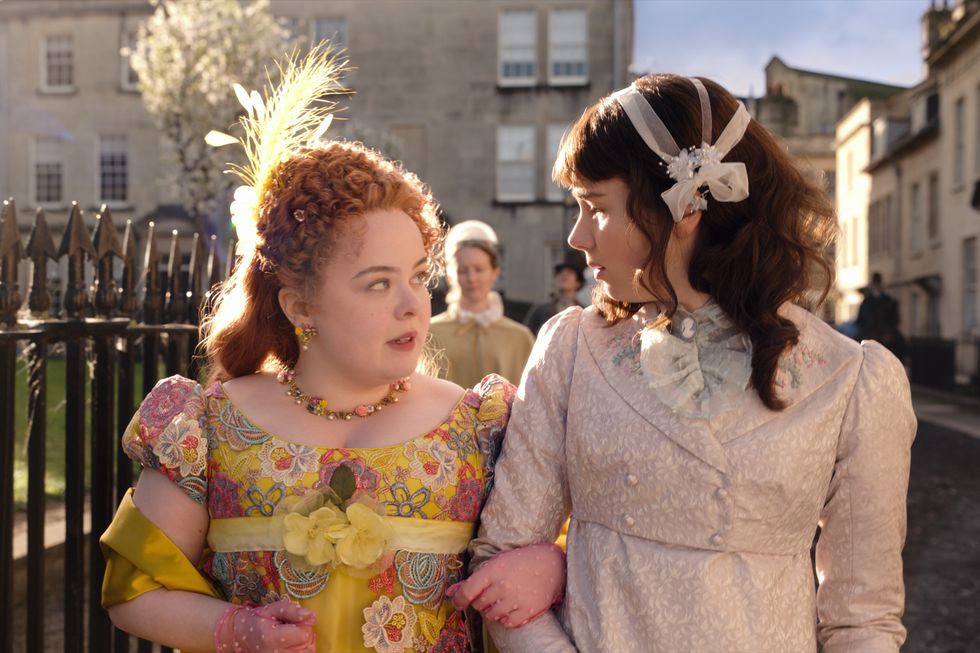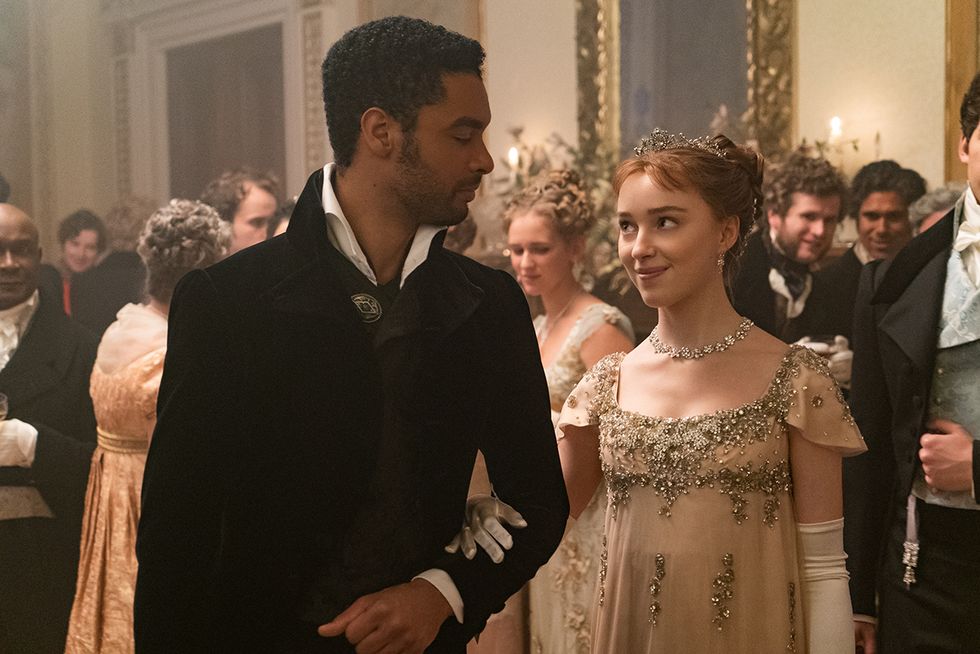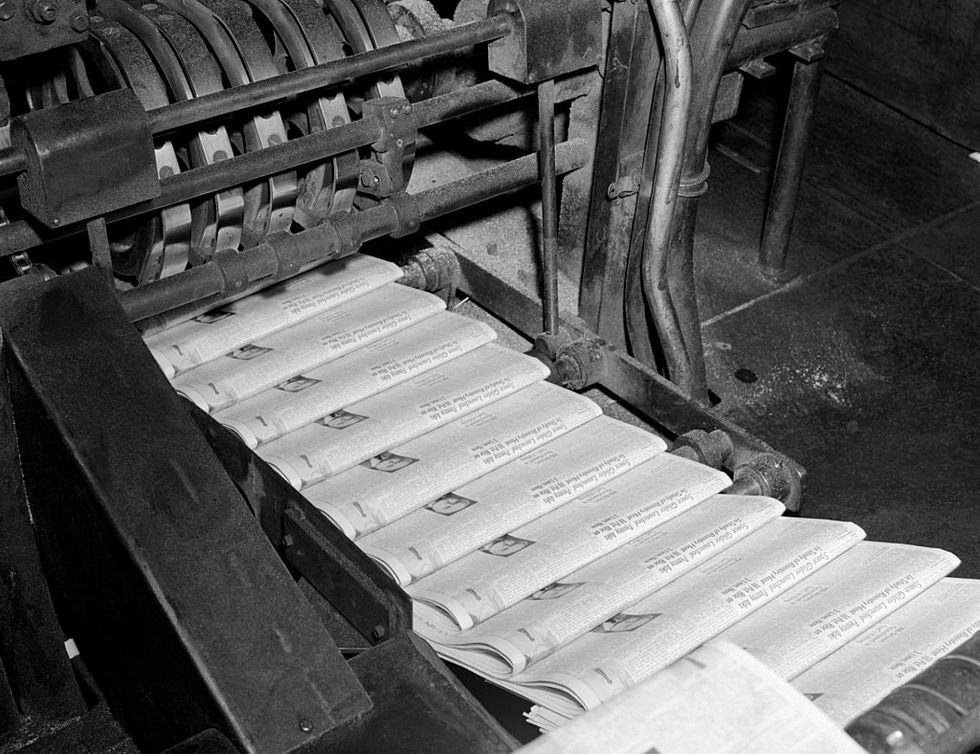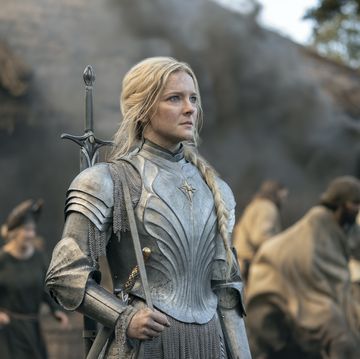In celebration of the release of Bridgerton season three, we're resharing this story, originally published in 2021, all about the secret history of high-society gossip in Regency England.
In Bridgerton, no one sends ripples of fear, delight, and raging curiosity through London’s upper crust society quite like Lady Whistledown, the anonymous yet all-knowing gossip maven who declares with acid-tongued authority which debutante is an “incomparable” and which scandal-tarnished aristocratic male would be better off leaving London at once.
In the new series, airing now on Netflix, even the Queen of England follows every syllable written by Lady Whistledown—and she, like the other characters, are often motivated by a desire to triumph over the gossip writer’s barbs or extinguish a smoldering scandal before it reaches quill and paper.
But is the character, who’s voiced by Julie Andrews, just a convenient foil for the British aristocrats in the series, or is she based on something more factual?
There have been rumblings among fans that this sort of “gossip sheet” comes from a later time than the early 19th century Regency period of Bridgerton, which based on a series of historical romance novels written by Julia Quinn. However, for two experts in the social customs of the Georgian and Regency period, a chronicler like Lady Whistledown has definite real-life precedents.
“Newspapers were plentiful during the Regency Era, with most of the stories published centering on politics, crime, fashion, infidelity, or royal doings,” says Geri Walton, author of Marie Antoinette’s Confidante and regular writer on 18th and 19th-century Europe. “I think any story that might stir up controversy and increase readership was covered by the press at the time. I’m also sure there were rumors and gossip about debutantes. The newspapers did focus on aristocrats and wealthy socialites.”
Historian Catherine Curzon, author of The Daughters of George III: Sisters and Princesses, says readers could closely follow the comings and goings of the upper classes in the popular “Fashionable World” newspaper columns, which were concerned with clothes, jewels and the general round of court balls and society events.
As for the acerbic Lady Whistledown, Curzon said she sounds somewhat similar to a real-life gossip writer from 18thcentury England.
“She does call to mind ‘Mrs. Crackenthorpe,’ billed as ‘a Lady that knows everything,’” says Curzon. “Mrs. Crackenthorpe was the anonymous author behind the Female Tatler, which was published from 1709 to 1710. It’s a gem of satire, remarkable for being intended for women, and with a primary aim to educate—often through sharp observation—but with an eye for gossip too. Though the Female Tatler was short-lived, other magazines flourished.”
According to Curzon, one of the most influential of these magazines was Town and Country Magazine (no relation!), published from 1769 to 1796. “It contained the Tête-à-Tête column, one of the first of what we would recognize as gossip columns,” explains Curzon. “Each month, it would choose a celebrity couple—though their names were redacted, they were shown in small portraits—and profile their love lives and associated scandals. Part of the social whirlwind of the coffeehouse was sharing these stories and working out exactly who the article was referring to!”
The Regency era didn’t offer whole newspapers dedicated to gossip, but many of the papers offered news and columns about the rich and titled and there was plenty of such writing included, and the public’s hungry for it was insatiable, agree Curzon and Walton. One gossip mainstay during the Regency era was the gorgeous, extravagant, and unhappily married Georgiana, Duchess of Devonshire (portrayed by Kiera Knightley in The Duchess). Another was Elizabeth Farren, a famous actress with a string of aristocratic lovers.
“It was rare for names to be published, but the codes used to disguise the identity of the subjects were deliberately easy to see through,” says Curzon. “This meant that it was simply a matter of decoding some fairly basic hints about the people involved, so a prince might be referred to as ‘an illustrious gentleman,’ or an actress by the name of her most notorious or celebrated characters.”
For a time, the most chronicled couple in the gossip columns were actress Mary Robinson and her lover, the Prince of Wales, later known as the Prince Regent and finally George IV, says Curzon.
“Both the press and the satirical printmakers referred to them as Perdita and Florizel, which echoed both Robinson’s most celebrated role and the pet names which the prince and his mistress gave to one another in their love notes,” Curzon says.
Interestingly, scandal sheets weren’t limited to the printed word.
“It was an era in which print shops and printmakers flourished,” Curzon says. “Caricatures of the rich and famous were merciless and they skewered scandals and spread gossip just as ably as any newspaper column, often saying far more in pictures than words could convey. For those who couldn’t afford to purchase a print, there was always the display in the printshop window, where they could enjoy the most shocking and often lewd examples without parting with any coin. It was a quick and easy way to pick up the latest gossip, much like the headlines on gossip magazines at the checkout today, or the sidebar celebrity gossip on news websites.”
During the Regency, the English were even more interested in the actions of the Royal Family than they are in today’s family members, say historians.
“The Prince Regent also often found himself a regular topic of the rumor-mongering press,” says Walton. “Gossip about him included even the most mundane things. One example of this is a story published by the Cumberland Pacquet and Ware's Whitehaven Advertiser in 1807 that went so far as to bring to the public news of the Prince’s eating habits: '[He] is now allowed to take half a pint of wine by his physicians. His general drink is barley water, and his food is simply small soup, fish, and salad. He has abstained from butchers' meat and poultry for several months.'"
It was not just gossip about the Royal Family and luxury-loving English aristocrats that caught the attention of readers during the Regency. Walton says that in the early 1800s, French rumors equally fascinated them. “They knew as much about what was happening in Paris as they did London,” she says. “Besides regularly perusing rumors swirling around Napoleon Bonaparte, his siblings, and their spouses, English journalists also reported on some of the more exciting French divorce cases.”
In Bridgerton, the characters are hopelessly obsessed with Lady Whistledown and in awe of her expertise: “She knows everything about everyone!” says one. In history, as in the new Netflix series, such a command of gossip would indeed reign supreme.

Nancy Bilyeau, a former staff editor at InStyle, Rolling Stone and Entertainment Weekly, has written a thriller set in the 18th century art and porcelain world titled 'The Blue.' For more information, see www.nancybilyeau.com.


















